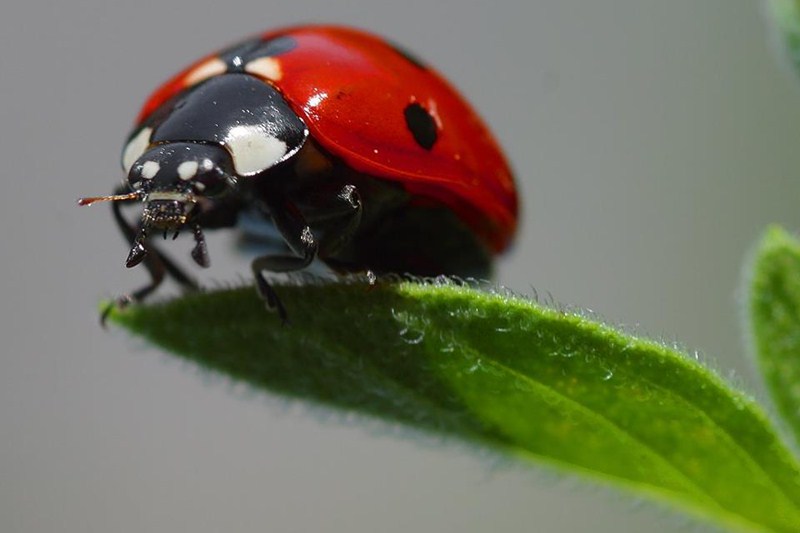Amazing Facts about Ladybugs
- Published by
- Posted on
- Leave your thoughts
-
Can there be a more adorable beetle than a lady bug? This is one bug that you wouldn’t mind crawling on the palm of your hand.
These bugs or should we say beetles, are scientifically called Coccinellidae and belong to the family of beetles. In North America they are known as ladybugs and in U.K. they are called ladybirds (because they can fly like birds). But the common names preferred by the entomologists are lady beetles or ladybird beetles. Other uncommon names for these bugs are lady fly, God’s cow, ladyclock and lady cow.

Ladybugs come in many different colors and patterns, but the most familiar in North America is the seven-spotted ladybug, with its shiny, red-and-black body
Their size ranges from 1mm to 10mm and there are over 5000 species of this insect out of which 450 are native to North America alone.
- Most beetles use their mouths to suck their food, but this situation does not hold true for the ladybugs. There are tiny pincers located inside the mouth of ladybugs with which they chew their food.
- These beetles are considered sacred since ancient times as there is a myth associated to its sacredness. It is believed that once in the medieval times, in Europe the crops were infected by pests, the peasants of that time prayed to the Virgin Mary. Their prayers were answered and ladybugs were sent in to destroy those pests. The bugs ate all the pests and the crops began to flourish again. Since that time these bugs were called lady beetles. It is also believed that the red color represents the cloak of the virgin Marry and the black spots represent her sorrows.
- As a defense mechanism, lady bugs protect themselves from predators by releasing a toxic fluid, hemolymph. The fluid is yellowish in color and is toxic in nature, and it is released from the joints of the legs. This foul smelling toxic repels their predators from eating them. Their larva also releases alkaloids from their abdomen.
- Also the vibrant red color of these insects indicates their toxicity. Scientists believe that the color is used to repel small birds and other predators that keep away from foods that are in red and black colors. This technique is also known as aposematia. The black spots on their bodies are also used to scare off its predators.
- Ladybugs usually eat small and soft bodied insects that are found in forests, farms and households. As previously mentioned they serve as potential predators for pests and can protect the farms from being invaded by these pests. Even today some peasants like to keep them in their farms and feed them, as they acknowledge their benefits. On average, almost 50 aphids are eaten by these beetles every day.
- Another unbelievable fact about ladybugs is that their larvae resembles small alligators, having spiky bodies, small stomach and legs protruding from the sides. The larvae take a month to grow into a teenage bug, and during this one month time it consumes as much aphid as an adult ladybug, i.e. up to 400 aphids in 2 to 3 weeks.
- We know that you wouldn’t try to eat one, but still for your information the larvae eggs of ladybugs are rich in proteins and highly nutritious. When a ladybird lays eggs there are a large number of fertilized and unfertilized eggs. The fertilized eggs mature and the unfertilized eggs serve as food for the larvaes.
- Just like cold blooded animals, ladybugs hibernate in winters and only prosper in warm temperature. As the temperature gradually falls, ladybirds hide themselves under the leaves and barks of the trees. You may find thousands of these insects at one hiding place.
- Though the bugs are harmless, but in warm season their population increases to such an extent that you can actually scoop them up and fill buckets with them. One of the bug invasions took place in the year 1976, in Somerset and Norfolk. People reported to find moving carpets of these tiny bugs, covering the entire area. Their mating season lasts from May till June and during that period a single bug can lay up to 2000 eggs.
- So what do these bugs do when there isn’t enough food? They cannibalize, yes it is true when the food gets scares the only way for their survival is to become cannibal. The sick and old bugs are eaten up by the healthy ones; also the newly turned bugs from the larvae have soft outer shells so they are eaten up by the mature ones. The situation gets quiet chaotic.
- When the lady bugs fly, they beat their wings 5100 times in a minute that is almost 85 beats in a second.
- Some people believe that they can determine the age of the lady bug by counting its spots, but that’s not true. The spots have nothing to do with their age. However, you can determine its species by the number of spots, e.g. the seven-spotted lady beetle will have 7 spots on its body.
- Besides the usual red and black color lady bugs are also found in yellow, brown and pink colors.
Apart from these ladybird facts you can start your own ladybug rearing farm to make sure that you always have enough ladybugs for your garden. There are ladybug farming kits that you can buy at some lawn and garden stores who sell ladybugs during the spring and summer seasons, or you can order a ladybug farm online any time of the year.





